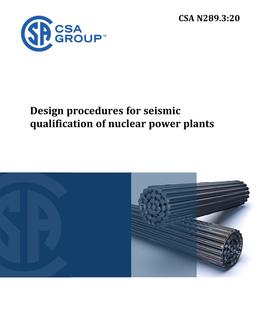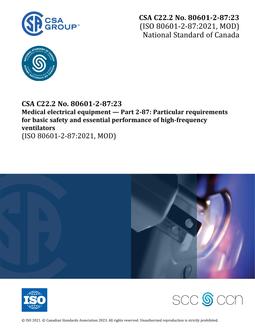
CSA N289.3:20
Click here to purchase
Preface:
This is the third edition of CSA N289.3, Design procedures for seismic qualification of nuclear power plants. It supersedes the previous edition, published in 2010 under the same title, and 1981 under the title Design Procedures for Seismic Qualification of CANDU Nuclear Power Plants. The title has been changed to reflect a scope change, from addressing only CANDU® reactors to including any nuclear power plant.
Note: CANDU (CANada Deuterium Uranium) is a registered trademark of Atomic Energy of Canada Limited (AECL).
There have been many changes throughout this edition of CSA N289.3; the most significant changes are as follows:
- The process for establishing design ground response spectra from probabilistic seismic hazard assessment (PSHA) results, including site response analysis, has been articulated in a more concise format and aligned with current good practices.
- Clause 7, Seismic design criteria, has been revised and re-structured to allow for a complete set of requirements for all cases and all structures, systems, and components (SSCs) that need to be addressed in nuclear power plant (NPP) design (including both “nuclear” and “non-nuclear” SSCs).
- A new Annex B (informative) on soil structure interaction (SSI) has been introduced in the Standard with the current established practices for SSI analysis. The body of this Standard is aligned with the Annex.
- The Standard has been aligned with recently published CSA Group standards, CNSC Regulatory Documents, and industry documents.
Standards in the CSA N289 series of Standards are developed in response to a recognition by the utilities and industries concerned with nuclear facilities in Canada of a need for the documentation of standards applicable to the seismic design and qualification of nuclear structures, systems, and components (SSCs) of nuclear power plants. Users of this Standard should recognize that it has the force of law only when adopted by the Canadian Nuclear Safety Commission (CNSC) or the appropriate authority having jurisdiction (in countries other than Canada).
The purpose of this Standard is to provide requirements that ensure that the nuclear SSCs are designed and seismically qualified in a manner using analytical techniques that meet a quality and standard commensurate with the safety principles necessary to comply with the Canadian nuclear safety philosophy.
The CSA N289 series of Standards consists of five Standards. Some of the objectives of each Standard are summarized as follows:
a) CSA N289.1-18, General requirements for seismic design and qualification of nuclear power plants — to provide guidelines for identifying structures and systems requiring seismic qualification based on nuclear safety considerations;
b) CSA N289.2-10, Ground motion determination for seismic qualification of nuclear power plants — to determine the appropriate seismic ground motion parameters for a particular site;
c) CSA N289.3-10, Design procedures for seismic qualification of nuclear power plants — to provide design requirements, criteria, and methods of analysis for
i) determining the design response spectra and ground motion time-histories to be used in the analysis;
ii) establishing design criteria for structures, systems and components (SSCs), and supports that require seismic qualification; and
iii) performing seismic analyses, including the effects of the soil-structure-interaction.
d) CSA N289.4-12, Testing procedures for seismic qualification of nuclear power plant structure, systems, and components— to provide design requirements and methods for seismic qualification of specific components and systems by testing methods; and
e) CSA N289.5-12, Seismic instrumentation requirements for nuclear power plants and nuclear facilities — to establish the requirements for seismic instrumentation and for seismic-related inspection of structures and systems before and after a seismic event.
The CSA N-Series Standards provide an interlinked set of requirements for the management of nuclear facilities and activities. CSA N286 provides overall direction to management to develop and implement sound management practices and controls, while the other CSA Group nuclear Standards provide technical requirements and guidance that support the management system. This Standard works in harmony with CSA N286 and does not duplicate the generic requirements of CSA N286; however, it may provide more specific direction for those requirements.
Users of this Standard are reminded that the design, manufacture, construction, commissioning, operation, and decommissioning of nuclear facilities in Canada are subject to the provisions of the Nuclear Safety and Control Act and its Regulations. The Canadian Nuclear Safety Commission (CNSC) can therefore impose additional requirements to those specified in this Standard.
Scope
1.1
This Standard specifies the requirements, criteria, methods of analysis, and design procedures for a) determining the design response spectra and ground motion time-histories to be used in the analysis;
b) establishing design criteria for structures, systems and components (SSCs), and supports that require seismic qualification; and
c) performing seismic analyses, including the effects of the soil-structure-interaction.
1.2
This Standard applies to SSCs in nuclear power plants that require seismic qualification by analytical methods (see CSA N289.1). This Standard may also be applied to SSCs that might not require explicit seismic qualification as deemed appropriate by the operating organization or by authorities having jurisdiction (AHJ).
1.3
This Standard may be applied, as appropriate, to other nuclear facilities under the jurisdiction of the Nuclear Safety and Control Act.
1.4
In this Standard, “shall” is used to express a requirement, i.e., a provision that the user is obliged to satisfy in order to comply with the standard; “should” is used to express a recommendation or that which is advised but not required; and “may” is used to express an option or that which is permissible within the limits of the Standard. Notes accompanying clauses do not include requirements or alternative requirements; the purpose of a note accompanying a clause is to separate from the text explanatory or informative material. Notes to tables and figures are considered part of the table or figure and may be written as requirements. Annexes are designated normative (mandatory) or informative (non-mandatory) to define their application.
Product Details
- Edition:
- 3rd
- Published:
- 01/01/2020
- ISBN(s):
- 9781488325243
- Number of Pages:
- 88
- File Size:
- 1 file , 1.6 MB
- Product Code(s):
- 2427921, 2427921


